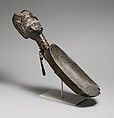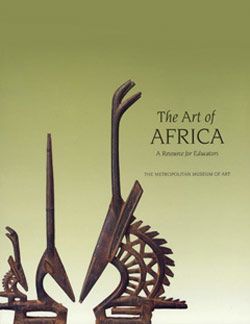Wunkirmian or wakemia feasting spoon
Artists in Dan communities of the Guinea coast have mastered the art of carving impressive, large wooden spoons that are virtuoso works of sculpture. The spoons are known by many names, including wakemia or wunkirmian, which roughly translates as "spoon associated with feasts." The spoons range in size from a foot to two feet and have one or (rarely) two parallel bowls. The handle of the spoon is always decorated and often is related to the human form; this example features a carved representation of a woman's head. Her elaborate coiffure has two large crescents extending front to back and two small crescents arching over the ears. The oval face features slit eyes and a generous mouth that contains four metal tab teeth. The nape of the neck is decorated with scarification patterns that emphasize its beauty and strength. The long, slender, lobed neck leads to the bowl of the spoon, which itself is decorated with incised, linear patterns on the outside surface. Other wunkirmian may feature a pair of legs as the handle, as opposed to the carved representation of a head as seen here.
Among the Dan, the owner of the spoon is called wa ke de, "at feasts acting woman." It is a title of great distinction that is given to the most hospitable woman of the village. With the honor, however, comes responsibility—the wa ke de must prepare the large feast that accompanies masquerade ceremonies. The excellent farming abilities, organizational talents, and culinary skills of the wa ke de are called upon to properly welcome and celebrate the masquerade spirits. When a woman has been selected as the main hostess of such a feast, she parades through town carrying the large spoon as an emblem of her status. On the day of the feast, she dances around the village dressed in men's clothes because "only men are taken seriously." She carries with her a wunkirmian and displays a bowl filled with small coins or rice. With help from her numerous assistants (usually female relatives or friends), she distributes grains and coins to the children of the community while dancing and singing her special song. The deep belly of the spoon from which this bounty is dispensed becomes the symbolic body or womb of the female figure. The event creates a profound visual analogy that honors the hostess, and women in general, as a source of food and life.
In addition to being emblems of honor, wunkirmian also have spiritual power. They are a Dan woman's chief liaison with the power of the spirit world and a symbol of that connection. Among the Dan, the wunkirmian have been assigned a role among women that is comparable to that which masks serve among the men. In many instances, wunkirmian are featured in the same ceremonies with masks, tossing rice in front of them as a blessing while they proceed through the village.
This spoon is attributed to Zlan of Belewale, one of the most famous sculptors of the region, and his wife Sonzlanwan. Zlan was a Wè sculptor who worked for many clients in several ethnic areas during the mid-twentieth century. In addition to being a great sculptor in his own right, Zlan was also a teacher who apprenticed many young carvers throughout his career. Many of these trainees were sent by regional chiefs to acquire his expertise for their own communities. Through his efforts, the small Wè village of Belewale—where his father had also been a sculptor—became an important carving center.
Defying the convention that woodcarving was a man’s vocation, Sonzlanwon (literally, "a snail, if god agrees") collaborated with her husband, Zlan of Belewale, on many of his greatest works. She accompanied him on commissions for important patrons—the intense concentration required to execute these was such that they often worked side by side in seclusion. Sonzlanwon is credited with blocking out Zlan’s works’ initial form, using wood felled by his apprentices. Following his refinement of the contours, she handled final detailing, including the braided raffia-palm coiffures added to figures and ladles. As Zlan aged, it is believed that Sonzlanwon’s role in their collaboration expanded. Documentation of her contributions derives from interviews conducted by German anthropologist Hans Himmelheber shortly before Zlan’s death, as well as from remembrances of surviving relatives and acquaintances.
This image cannot be enlarged, viewed at full screen, or downloaded.


